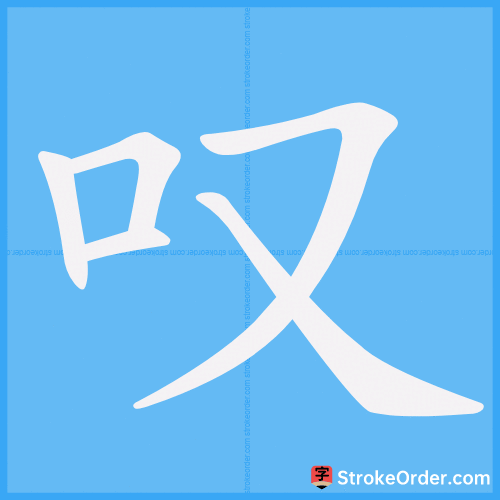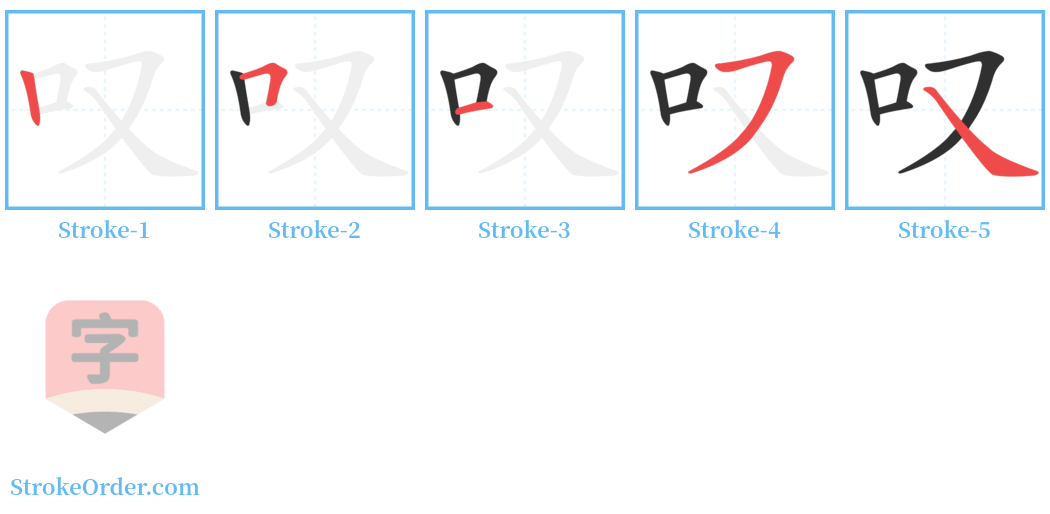叹 Stroke Order
Animated Stroke Order of 叹

Stroke Order Diagrams for 叹

Step-by-Step Handwriting Guide for 叹

Learn to Write Chinese Characters with Video Tutorials
Watch the video of writing the Chinese character "叹", learn the correct stroke order (笔顺) of the character "叹", and master the standard way of writing the character "叹".

Free Printable Handwriting Practice with Stroke Order: 叹
Printable Writing Practice Worksheet of "叹" in Portrait Orientation (Tian Zi Ge)

Printable Writing Practice Worksheet of "叹" in Landscape Orientation (Tian Zi Ge)

Information of 叹
Pinyintàn
Radical
口
Strokes
5 strokes
Usage
★★★★★
Definition
to sigh
叹 tàn 〈动〉 【本义】:叹息 1. To exhale a long breath due to worry, sadness, or pain. Examples: 叹气 (sigh); 叹息 (sigh); 悲叹 (lament); 叹惋 (sigh with regret); 长吁短叹 (sigh repeatedly). 2. To release a long sound due to happiness, excitement, or agitation. Examples: 叹赏 (praise); 叹服 (admire); 赞叹 (highly praise); 叹观止矣 (to praise something to the utmost). 3. To chant or recite. Examples: 咏叹 (to chant); 一唱三叹 (a sing-and-sigh expression). 引 1. 从《说文》: 叹,吞叹也。一曰太息也 (From "Shuowen Jiezi": to sigh, which can also mean to take a deep breath). 2. 禽子再拜而叹 (From "Mozi": the bird bowed twice and sighed). 3. 戏而不叹 (From "Liji": to play but not sigh). 4. 望洋向若而叹 (From "Zhuangzi": to gaze at the vast ocean and sigh). 5. 皆叹惋 (From Jin Dynasty author Tao Yuanming's "Peach Blossom Spring": all sighed with regret). 6. 默叹曰 (From Ming Dynasty author Liu Ji's "Yuli Zi": silently sighed and said). 7. 婉贞微叹曰 (From Qing Dynasty author Xu Ke's "Qing Bai Lei Chao": Wan Zhen sighed softly). 8. 叹借者之用 (From Qing Dynasty author Yuan Mei's "Huang Sheng Jian Shu Shuo": sigh regarding the use of borrowed items). 例 又如: 叹气嗐声 (to sigh and moan); 叹恨 (to sigh with regret); 叹憾 (to sigh with remorse); 叹笑 (to scoff and sigh); 叹悔 (to sigh with regret); 叹喟 (to sigh deeply); 叹嗟 (to sigh); 叹想 (to sigh in reminiscence); 叹诧 (to sigh in astonishment); 长叹 (to take a long sigh); 叹一口气 (to exhale a breath). 2. 赞叹,赞美 ([En.] highly praise) 引 1. 默叹 (From "Yu Chu Xin Zhi": to sigh silently). 2. 亟叹其技 (From Qing Dynasty author Xue Fucheng's "Guan Baji Oil Painting Record": to urgently praise their skill). 例 又如: 叹重 (to highly respect and praise); 叹奖 (to commend and reward); 叹嘻 (to exclaim in praise); 叹骇 (to express astonishment and praise); 叹为观止 (to praise to a remarkable degree); 叹异 (to be astonished and praise). 3. 吟诵 ([En.] chant) 引 1. 叹,吟也 (From "Shuowen": to chant). 2. 智勇盖当代,弛张使我叹 (From "Wenxuan": may wisdom and strength be equally revered in this time, they make me sigh). 3. 一唱而三叹 (From "Liji": to chant and then sigh three times). 例 又如: 叹诵 (to chant).
to exclaim in admiration
to sigh (with feeling) / to lament
long sigh / deep sigh
sighing voice, wailing breath (idiom) / to heave deep sighs / to sigh in despair
to sigh with regret / lament
to exclaim in admiration / a gasp of surprise
to sigh / to heave a sigh
alas / sigh
(idiom) to gasp in amazement / to acclaim as the peak of perfection
(to gasp) with admiration
lamentable / sad(ly)
to sigh / to lament / to bewail
lament / bemoan / heave a sign
chant / sing / intone
to be full of praise (idiom)
long moan and short gasp (idiom); continually moaning and groaning in pain
to bewail / to sigh mournfully / to lament
aria
shake one's head and sigh / shaking the head and uttering a sigh
sigh with deep feeling
Lament
to sigh / to gasp (in admiration)
sigh in sympathy
sigh of regret
Sigh
Linghu sighed
Input Method for 叹
Pinyintan4
Wubi
kcy
Cangjie
re
Zhengma
jxs
Four Corner
67040
Unicode
U+53f9
Same Pronunciation Characters
叹坛坦探摊檀毯滩潭炭痰瘫碳谈谭贪坍忐昙袒覃赕郯钽啴嘆嘽壇攤曇歎灘癱罈襢談譚貪锬舑傝怹痑潬擹倓埮惔婒弾榃墰墵醈憛橝顃藫壜醰貚譠罎菼鉭嗿憳醓暺憻璮湠僋舕撢賧鷤錟䕊㷋㲜㲭䐺䏙㽑䃪䆱䊤䉡䜖䞡䦔
Same Radical Characters
口古句另叨叩只叫召叭叮可台史右叶号司叹叼叽吁吃各吆合吉吊同名后吏吐向吓吕吗君吝吞吟吠否吧吨吩含听吭吮启吱吴吵吸吹吻吼吾呀呈告呐呕员呛呜周味呵呻呼命咄咋和咏咐咒咕咖咙咧咨咪咬咱咳咸咽哀品哄哆哇哈哉响哎
本文来自傲气一世投稿,不代表汉字笔顺中文网英文版立场,如若转载,请注明出处:https://www.strokeorder.cn/strokeorder/8200.html

 微信扫一扫
微信扫一扫 